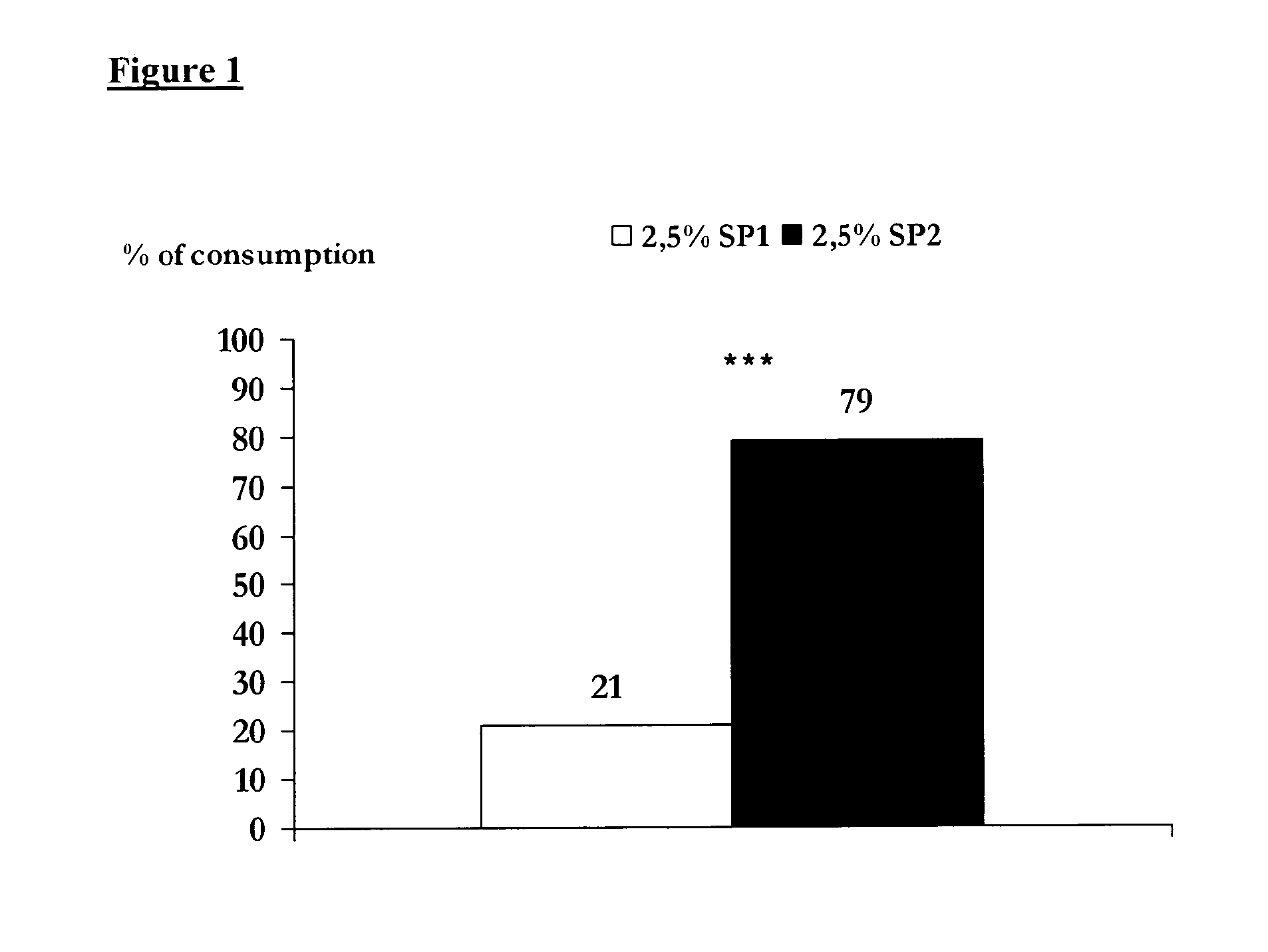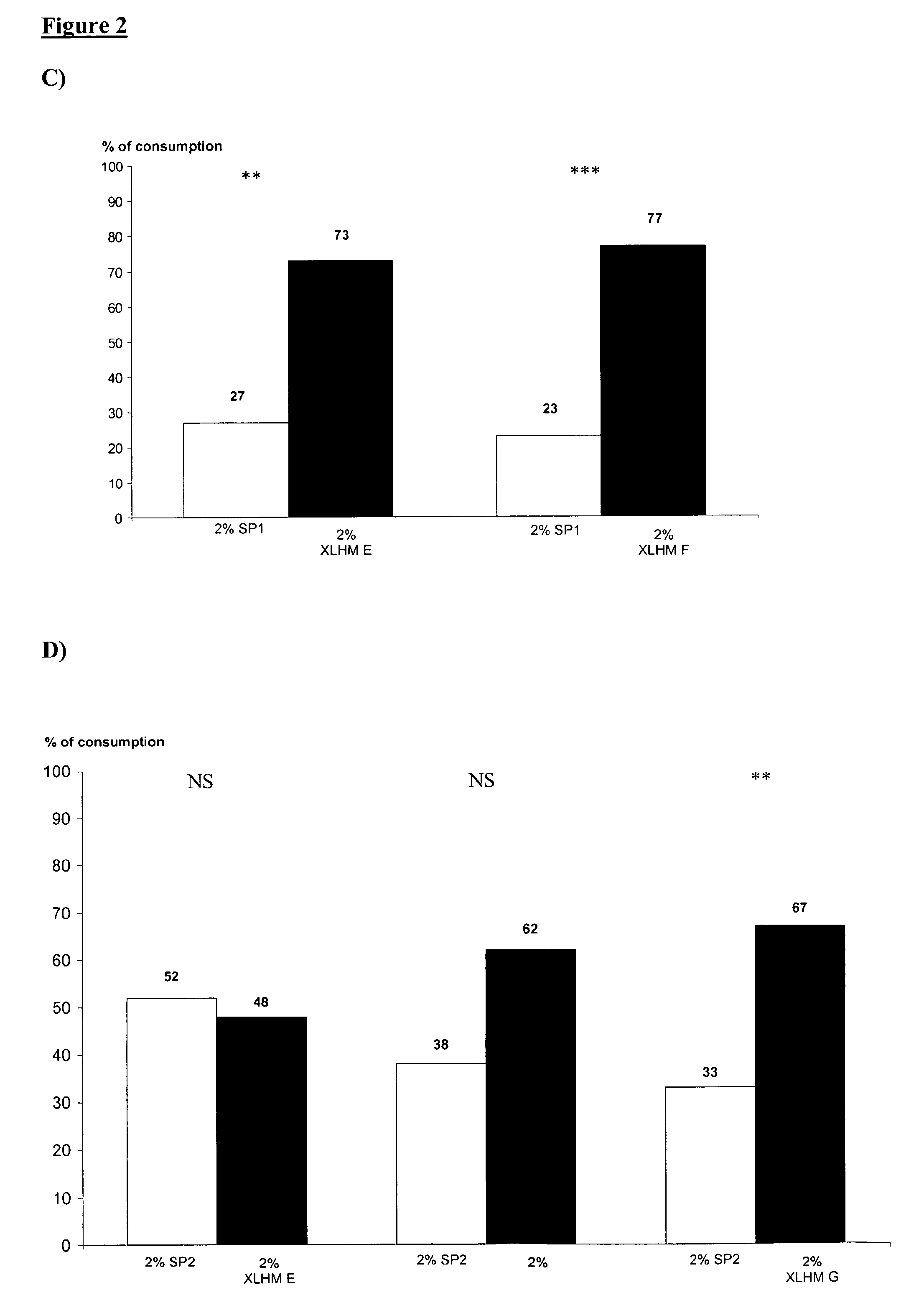Method for enhancing pet food palatability
a pet food and palatability technology, applied in the field of palatability enhancement, can solve the problems of not being able to achieve the effect of enhancing and being able to achieve the effect of great value in the palatability of pet food
- Summary
- Abstract
- Description
- Claims
- Application Information
AI Technical Summary
Benefits of technology
Problems solved by technology
Method used
Image
Examples
example 1
XLHM Product with Starting Raw Material
[0078]Formulation
TABLE 1Components%Starting raw material78.43Fat7.18Caustic soda3.10Reducing Sugars1.79Nitrogen compounds2.24Protease enzyme0.50Lipase enzyme0.05Emulsifiers0.60Phosphoric acid5.73Potassium sorbate0.36Preservatives and antioxidants0.02
[0079]Method:
[0080]Raw materials, exogenous and / or endogenous proteases, preservatives and antioxidants are mixed together, and heated at a temperature of about 60 to 70° C. during at least 30 minutes (step a)(i)).
[0081]The mixture is heated and maintained at about 85° C. for at least 10 minutes to be pasteurized, then it is cooled at about 25 to 45° C., preferably with an associated filtration, so as to obtain the first stage reaction product (step a)(ii)).
[0082]Optionally, it is possible to add here a storing step, under appropriate conditions for a given period, with a prior acidification process.
[0083]Then, the pH is adjusted at about 7 to 10 by using caustic soda, or a basicity regulator, and e...
example 2
XLHM Product with Starting Digest
[0092]Formulation:
TABLE 4Components%Starting digest59.49Water11.18Fat6.71Caustic soda12.13Reducing Sugars1.39Nitrogen compounds1.74Lipase enzyme0.05Emulsifiers0.64Salts0.24Phosphoric acid6.18Potassium sorbate0.23Preservatives and antioxidants0.02
[0093]Method:
[0094]The starting product used in this example is a digest as obtained after step a) (i) and (ii) illustrated in Example 1, that is to say the first reaction product.
[0095]The method begins with steps b), c) and d), where the pH is adjusted at about 7 to 10 by using caustic soda, or a basicity regulator, and emulsifiers, fat and lipase enzymes are added for lipolysis during at least 120 minutes and preferably about 120 to 420 minutes, as so to obtain the second stage reaction product.
[0096]Reducing sugars and nitrogen compounds are then incorporated, and the resulting mixture is heated at about 90 to 110° C. during at least 30 minutes, so as to obtain a palatability enhancer (step e).
[0097]Final...
example no 5
Addition of XLHM Product Version G in a Loaf for Cat Formulation of Product B
[0120]
TABLE 10ComponentskgsFrozen pork lungs and liver2.376Frozen chicken lungs and liver5.232Frozen chicken carcass3.912Texturizing agents0.235Mix of vitamins & minerals0.072Wheat flour1.200XLHM version G0.720Water10.253
[0121]Formulation of Product C
TABLE 11ComponentskgsFrozen pork lungs and liver2.811Frozen chicken lungs and liver5.271Frozen chicken carcass3.932Texturizing agents0.235Mix of vitamins & minerals0.072Wheat flour1.200C'sens W9P powder0.240Water10.238
[0122]Definition: C′sens W9P is a commercially available SPF Super Premium palatability enhancer intended for wet pet food applications
Method
[0123]Raw materials (pork lungs, pork livers, chicken lung and liver, chicken carcass) were allowed to thaw overnight at room temperature. Then they were ground in a vertical cutter (Stephan, Germany) for 5 min at 1500 tr / min. Water was poured into a bucket. The powders (Texturizing agents, Mix of vitamins & ...
PUM
 Login to View More
Login to View More Abstract
Description
Claims
Application Information
 Login to View More
Login to View More - R&D
- Intellectual Property
- Life Sciences
- Materials
- Tech Scout
- Unparalleled Data Quality
- Higher Quality Content
- 60% Fewer Hallucinations
Browse by: Latest US Patents, China's latest patents, Technical Efficacy Thesaurus, Application Domain, Technology Topic, Popular Technical Reports.
© 2025 PatSnap. All rights reserved.Legal|Privacy policy|Modern Slavery Act Transparency Statement|Sitemap|About US| Contact US: help@patsnap.com



